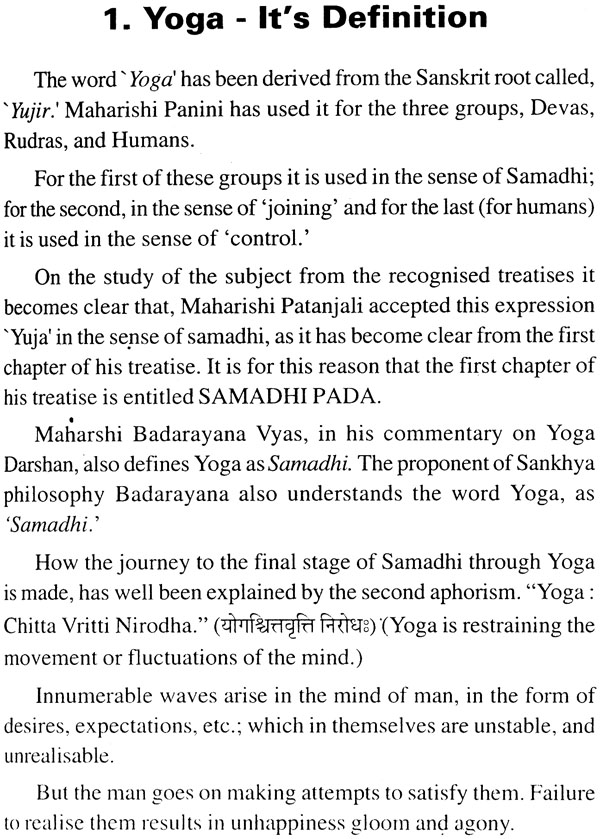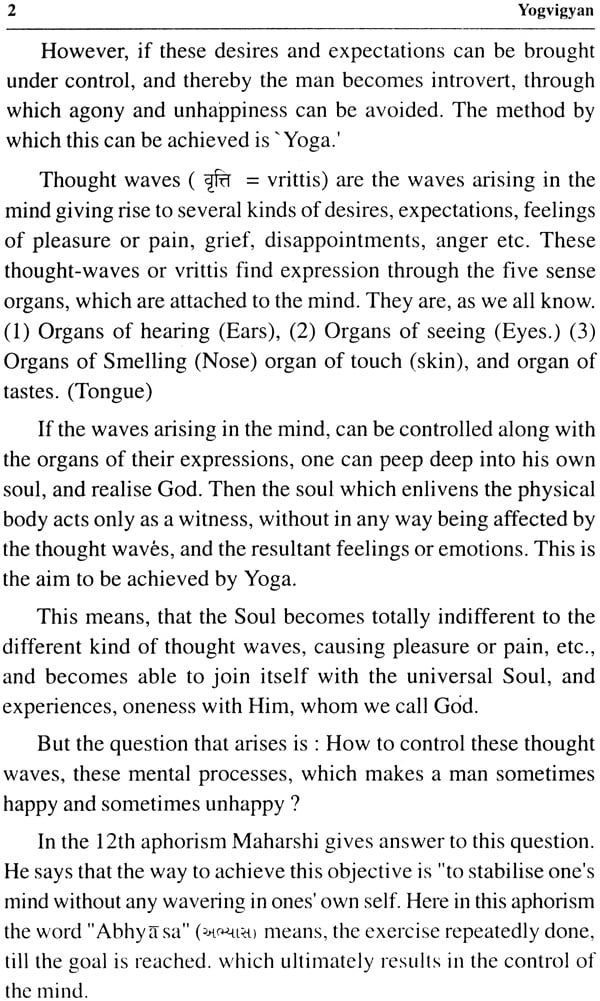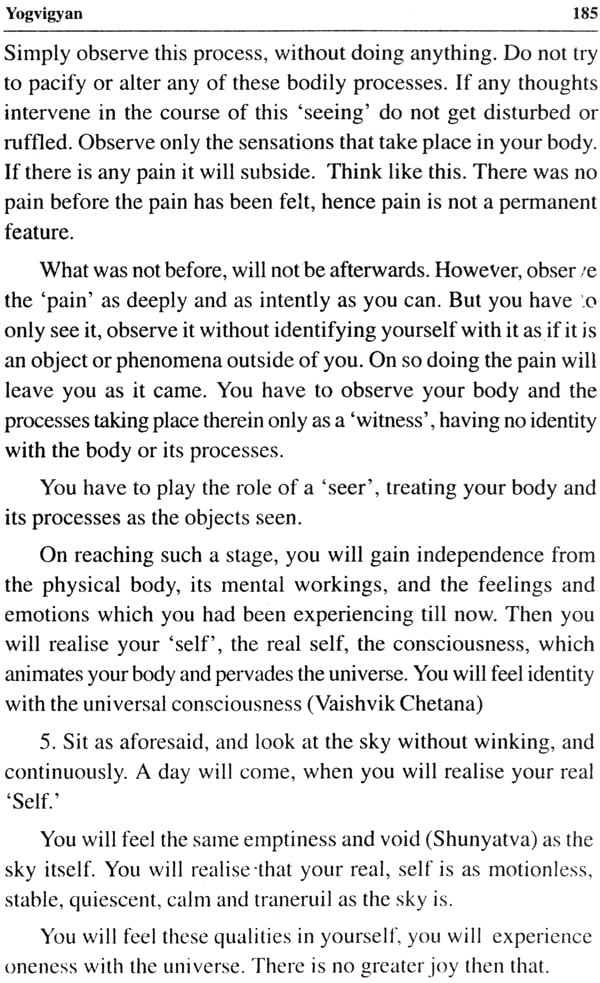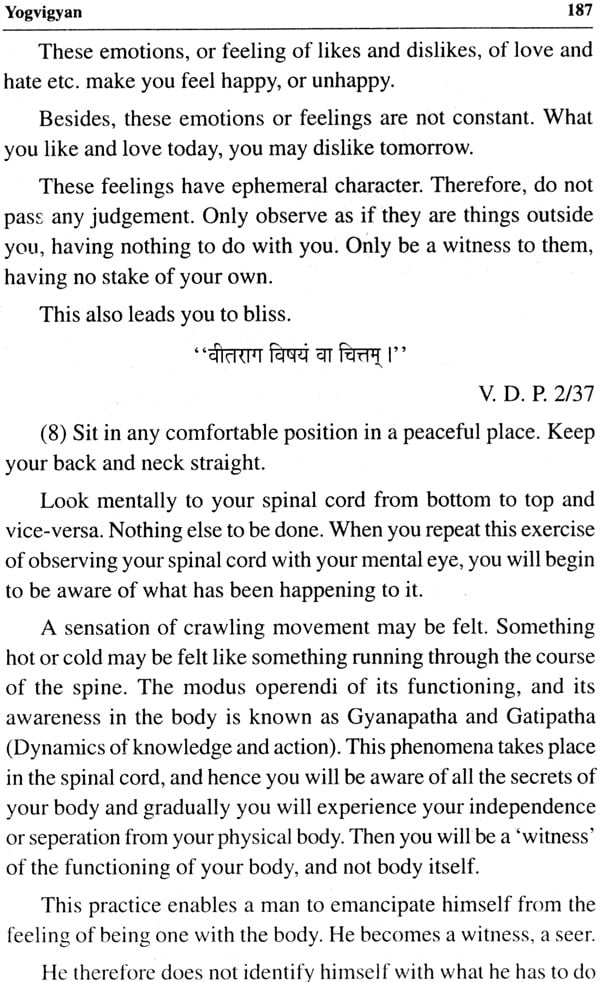
YOGA VIGYAN
Book Specification
| Item Code: | IDF650 |
| Author: | Swami Aditya Yogi |
| Publisher: | Sastu Sahitya Mudranalaya Trust |
| Language: | English |
| Edition: | 2003 |
| Pages: | 195 (B & W Illus: 94) |
| Cover: | Hardcover |
| Other Details | 8.6" X 5.7" |
| Weight | 330 gm |
Book Description
About the Author:
I am extremely glad to give a short biographical sketch of Rev. Acharyaji though it is beyond my capacity to introduce such a venerable personality to the reader.
Despite this with the blessings of Swamiji I venture to write a few words. His father Paramahansa Prasadji and mother Smt. Savtri Devi have done a great obligations not only on the people of this country, but also on the entire world by giving birth to such a personality as Swamiji is.
we have to express our gratitude to All-Mighty Who brought forth on this earth so venerable a person through the instrumentality of these parents.
By his effort those who follow his precepts, become enlightened and attain to peace. Since childhood he aspired to realize that ultimate BEING Who is the source of supreme bliss.
He has heard the story of Ganga, on whose banks the yogis were performing their meditation with the very same idea he went to Shukratal where Shukadev had related to king Parikshita the story of Bhagawat.
After visits of several scared places, he came to Nigma Ashram, on the bank of the river Ganga. There, he passed sometime in meditation. Then he come to Hardwar and then Rishikesh. He traveled further on and came to Gangotri a mountaineous place in which Ganga makes appearance and settled their. At present he is living in a cave in Gangotri.
With the flowing of the scared waters of Ganga is flowing the yogic knowledge Gyan Ganga of Swamiji from the heights of the Himalayas.
PREFACE:
Today several books on the subject of Yoga are available in the market a question may arise why then to add one more to the already available literature on the subject?
Some friends told me that common understanding of the people about yoga is that it is system of some physical exercise done in the form of some postures. In such a situation it was necessary to present before the people Yoga Darshan of Maharajshri Patanjali which aimed at the overall development of the human beings and there by to enable them to make spiritual progress. But today the people make beginning with postures and leaving aside the eight fold path of yoga as preached by Maharajshri Patanjali which also includes disciplines like Yama, Niyama, Asana, Pranayama, Dharana, Dhyana and Samadhi.
The result is that Yama and Niyama which contribute to the happiness of the people are side tracked. It was therefore suggested that I should write a book, based on my own experience giving a complete and scientific idea what yoga as preached by Patanjali is so that all interested in the subject may benefit.
in this book attempt has been made to give the definition Yoga besides giving the methods of exercising the same. Attempt has been made to explain various Asanas and methods of Pranayam in simple and forth sight manner in several chapters of this book. It is hoped that this book will benefit all without any distinction of cast, creed or religion.
In Indian Culture, Yoga philosophy occupies a very important place. Its principles are so practical and widely known, that it has influenced almost all the aspects of Indian life. Yoga promises its adherents healthy growth and a long life.
Prana assumes in the body the character of Agni (Fire) and it is the primordial cause of life.
It is Prana which imparts life to otherwise a non-living entity.
Shri Aditya Yogiji by writing a treatise on this Prana, has rendered a commeadable service to the society.
This book is a complete treatise, on the subject of yoga, written in simple language.
On Studying it from beginning to end, I venture to state that it will provide good guidance to all those who intend to take up the study of the subject, and provide inspiration and guidance to the aspirants.
| 1 | Yoga-It's Definition | 1 |
| 2 | Yama | 5 |
| 3 | Niyama (Rules of Conduct) | 17 |
| 4 | Diet: The Accessory of Asanas | 28 |
| 5 | The Function of Food | 32 |
| 6 | Essential Elements of Food | 34 |
| 7 | Table Showing the Amount Vitamin from Eatables | 35 |
| 8 | Chemical Constituents of Food Items | 36 |
| 9 | Normal Quantities for Daily Consumption | 39 |
| 10 | Calories Needed Daily | 42 |
| 11 | Proportion of Nutritive Factors in Fruits | 43 |
| 12 | Principles based on Tridosh | 46 |
| 13 | Selection of Different Food items in Different Diseases Resulting from Different Doshas | 48 |
| 14 | Postures and Body-cleanliness | 50 |
| 15 | Mala shodhana-cleansing the body by Excertion | 51 |
| 16 | Six ways of cleansing the body | 52 |
| 17 | Asanas- Postures | 63 |
| 18 | Bandha | 135 |
| 19 | Pranayama: Introduction and Utility | 138 |
| 20 | Pranayama | 141 |
| 21 | Pranayama and Dhyama based on other systems | 159 |
| 22 | Mudras | 161 |
| 23 | Pratuahara | 177 |
| 24 | Swara Samanvaya: Harmonious Breathing | 180 |
| 25 | Dharana | 181 |
| 26 | Dhyana | 182 |
| 27 | Samadhi | 189 |
| 28 | March forward towards the final Goal- Godliness | 190 |
| Yoga & Diseases Cured | 192 |













